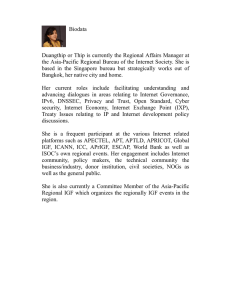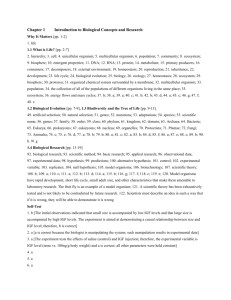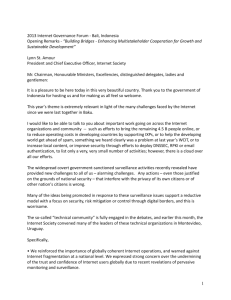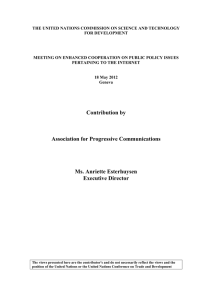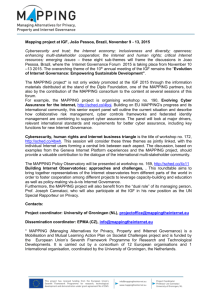Gene expression of the insulin-like growth factors and their
advertisement
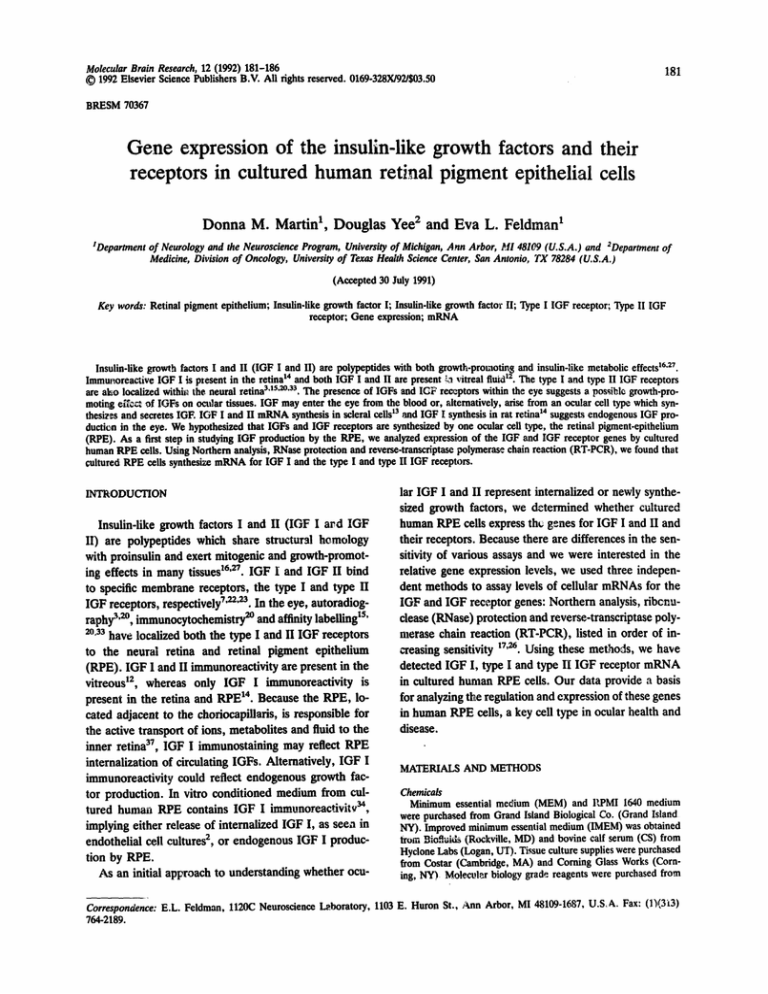
Molecular Brain Research, 12 (1992) 181-186 © 1992 Elsevier Science Publishers B.V. All riots reserved. 0169-328X/92/$03.50 181 BRESM 70367 Gene expression of the insulin-like growth factors and their receptors in cultured human retinal pigment epithelial cells Donna M. Martin ~, Douglas Yee 2 and Eva L. Feldman 1 ZDepartment of Neurology and the Neuroscience Program, University of Michigan, Ann Arbor, HI 48109 (U.S.A.) and 2Department of Medicine, Division of Oncology, University of Texas Health Science Center, San Antonio, TX 78284 (U.S.A.) (Accepted 30 July 1991) Key words: Retinal pigment epithelium; Insulin-like growth factor I; Insulin-like growth factor II; Type I IGF receptor; Type II IGF receptor; Gene expression; mRNA Insulin-like growth factors I and II (IGF I and II) are polypeptides with both growth-promotin$ and insulin-like metabolic effects 16"27. Immunorea~ive IGF I is present in the retinat4 and both IGF I and II are present ~ vitreal fluid12. The type I and type II IGF receptors are a~o localized withi~ the neural retina3a5"2°'33. The presence of IGFs and IGF receptors within the eye suggests a possible growth-promotir~g e~f~.ct of IGFs on ocular tissues. IGF may enter the eye from the blood or, ~iternatively, arise from an ocular cell type which synthesizes and secretes IGF. IGF I and II mRNA synthesis in scleral ceils~3 and IGF I synthesis in rat retina 14 suggests endogenous IGF productit~n in the eye. We hypothesized that IGFs and IGF receptors are synthesized by one ocular cell type, the retinal pigment-epithelium (RPE). As a first step in studying IGF production by the RPE, we analyzed expression of the IGF and IGF receptor genes by cultured human RPE cells. Using Northern analysis, RNase protection and reverse-transctSptase polymerase chain reaction (RT-PCR), we found that cultured RPE cells synthesize mRNA for IGF I and the type I and type 1I IGF receptors. INTRODUCTION Insulin-like growth factors I and II (IGF I a r d I G F II) are polypeptides which share structural homology with proinsulin and exert mitogenic and growth-promoting effects in many tissues 16'27. I G F I and I G F II bind to specific membrane receptors, the type I and type II IGF receptors, respectively 7'22'~. In the eye, autoradiography ;,2°, immunocytochemistry 2° and affinity labelling 15' 2o.33 have localized both the type I and II I G F receptors to the neural retina and retinal pigment epithelium (RPE). I G F I and II immunoreactivity are present in the vitreous n , whereas only I G F I immunoreactivity is present in the retina and R P E u . Because the R P E , located adjacent to the choriocapillaris, is responsible for the active transport of ions, metabolites and fluid to the inner retina 37, IGF I immunostaining may reflect R P E internalization of circulating IGFs. Alternatively, I G F I immunoreactivity could reflect endogenous growth factor production. In vitro conditioned medium from cultured human R P E contains I G F I immunoreact-ivitv 34, implying either release of internalized IGF I, as seea in endothelial cell cultures 2, or endogenous IGF I production by RPE. As an initial approach to understanding whether ocu- lar IGF I and II represent internalized or newly synthesized growth factors, we determined whether cultured human R P E cells express th~ genes for IGF I and II and their receptors. Because there are differences in the sensiti,Aty of various assays and we were interested in the relative gene expression levels, we used three independent methods to assay levels of cellular mRNAs for the IGF and I G F receptor genes: Northern analysis, ribcnuclease (RNase) protection and reverse-transcriptase polymerase chain reaction (RT-PCR), listed in order of increasing sensitivity t7,26. Using these methods, we have detected I G F I, type I and type II IGF receptor m R N A in cultured human RPE cells. Our data provide a basis for analyzing the regulation and expression of these genes in human R P E cells, a key cell type in ocular health and disease. MATERIALS AND METHODS Chemicals Minimum essemial medium (MEM) and PJ'MI 1640 medium were purchased from Grand Island Biological Co. (Grand Island NY). Improved minimum essential medium (IMEM) was obtained ~ora Biofiuids (RockviUe, MD) and bovine calf serum (CS) from Hycione Labs (Logan, Lrl'). Tissue culture supplies were purchased from Costar (Cambridge, MA) and Coming Glass Works (Corning, NY) Molecular biology grade reagents were purchased from Correspondence: E.L. Feldman, 1120C Neuroscience L,~boratory, 1103 E. Huron St.,/~mn Arbor, MI 48109-1687, U.S.A. Fax: (D(Tt3) 764-2189. 182 Sigma. All other chemicals were of reagent grade and obtained from Baker Chemical Co. (Phillipsburg, NJ) or Fisher Scientific (Fairhave~, NJ). Cell c:~lture Retinal pigment epithelia were isolated from human post-mortem eyes provided by the Michigan Eye Bank. Primary RPE cell cultures were estabfished as previously describeds. Cells were periodically subcuitured at a density of 3-5 x 106 cells per 75 cm2 tissue culture flask in MEM containing 20% CS. Ceils were maintained at 37 °(3 in a humidified atmosphere of 5% CO2 and 95% 0 2. Medium was changed 3 times weekly. Breast cancer cell line MD,~-MB231 was obtained from American Type Culture Collection (ATCC, Rockville, MD) and maintained in IMEM with 10% CS. The human neuroblastoma cell line SK-N-SH was obtained from J. Biedler, Memorial Sloan-Kettering Institute (New York, NY) and maintained in RPMI 1640 medium with 10% fetal CS. Northern analysis Total cellular RNA was isolated from cells or tissues by guanidinium thiocyanate-phenol extractions. Poly(A) + and poly(A) RNA were selected by oligo(dT) cellulose chromatography following the manufacturer's protocol (Pharmacia, Gaithersburg, MD) 1. The hut,ran IGF IA cDNA was kindly provided by Dr. Peter S. Rotwein (Washington University School of Medicine, St. Louis, MO) 24. An 818-base pair (bp) region of IGF IA cDNA encoding exons i, 2, 3 and 5 was excised from pBlueScript KS (Stratagene, La Jolla, CA) by digestion with EcoRI (Stratagene, La Jolla, CA). The cDNA for human IGF II was kindly provided by Dr. Graeme I. Bell (Howard Hughes I~stitme, Chicago, IL)4. An 854-bp region of IGF II cDNA enco~lin~ exons 7, 8 and part of 9 was excised from pGEM4 (Promega, Madison, WI) by digestion with Pstl. Type I IGF receptor eDNA was obtained from Dr. Axel Ullrich (Max Planck Institute, Munich, F.R.G.) 32. A 1247-bp insert encoding part of the type I IGF receptor a and fl chains was excised by digestion of pGem4 with EcoRI and HindIII (Stratagene, La Jo!!a, CA). All templates were 32p.labelled by random priming (Amersham, U.K.) for use in hybridization reactions. RNA samples (1-10/~g) were d.;ssolved in 37.5% formamide, 1.6 M formaldehyde and 1.5 mM sc,dium phosphate buffer. RNA samples were electrophoresed in denaturing gels (1% agarose, 2.2 M formaldehyde, 0.02 M sodium phosphate buffer) and transferred to Nytran nylon membranes (Schleicher & Schuell, Keene, NH) by capifiary blotting. After transfer, 40-100 ng of denatured IGF I and IGF II cDNA were applied to the membrane for positive and negative hybridization efficiency controls. Nucleic acids were baked o~to membranes for 30 min at 65-80 °C. Membranes were hybridized in 40% formamide, 1.1 M NaCl, 60 mM NaH2PO4, 6 mM EDTA, 1.0% sodium dodecyl sulfate (SDS), 10% dextran sulfate, 100-200/~g/ml denatured salmon DNA and 32p-labeUed cDNA probe (I-5 × I05 cpm/mi) for 12-16 h at 42 °C. Membranes were washed twice for 15 min in 0.36 M NaCI, 20 mM NaH2PO4, 2 mM EDTA and 0.1% SDS at room temperature and twice for 15 min at 65 °(3 in 90 mM NaCl, 5 mM NaH2PO4, 0.5 mM EDTA and 0.1% 217 201 190 180 160 147 -854 -622 -527 -404 -309 -238 -217 Primers used in the RT.PCR assay Primers used Reverse transcriptase-polymerase chain reaction (RT-PCR) One/~g of total cellular RNA was transcribed into complimentary DNA. Briefly, in a 20/d volume of 1 x PCR buffer (Pe~kin Elmer Cetus, Norwalk, CT), 1 mM each dNTP (Sigma), 1 Ul/d RNAsin (Boehringer-Mannheim, Indianapolis, IN), 100 pM random hexamer (Sigma) and 200 U of Moloney MuLV reverse transcriptase (Bethesda Research Labs, Bethesda, MD) were added to 1/~g of total cellular RNA (or water for control samples) and incubated for 60 min at 42 °(3. The reaction was hea~-inactivated at 95 °(3 for 5 min, then placed on ice. To each 20/d reaction, 8/d 10x PCR buffer, 69/A sterile H20, 1/d each of an upstream and downstream primer and 1/d of I U//A Taq DNA pol~merase (Perkin Elmer Cetus, Norwalk, CT) were added and placed in a ther- 242/ TABLE I Gene SDS. For high stringency, membranes were washed twice for 15 min at 65 °(3 in 18 mM NaCI, 1 mM NaH2PO4, 0.1 mM EDTA and 1.0% SDS. Membranes were exposed to X-ray film (Kodak) in the presence of an intensifying screen at -70 °(3 for 1-7 days. Lo. cation Product Re£ size IGF-I TCACATCTCTrCTACCTGGC Exon 2 GTAGGTCTI'GTI'I'CCTGCAC Exon5 366 bp IGF-II GAGTGCTGCTrCCGCAGCTG Exon 3 TCTCTGAACGCTrCGAGCTC Exon 4 249 bp 28 Fig. 1. A: IGF I exon 3 R~ase protection assay in human cultured RPE cells. An antisense RNA probe was transcribed from ~ 1-kb segment of the IGF I gene that contained 182-bp of exon 3. Liver RNA protected the appropriate sized fragment, while RPE RNA did rot. Radiograph exposed 36 h. B: IGF II RNasc protection assay in cultured human RPE cells. An 854-bp IGF ~I cDNA obtained from human liver was used as a probe template. RPE ~id not protect this probe, while the neuroblastoma cell line SK-N-SH protected an expected 580 bp. Radiograph exposed 48 h. 183 mal cycler for 40 cycles, using the PCR cycle profile recommended by the Taq DNA polymerase manufacturer. The sequences of oligonucleotide primers used are outlined in Table I. Primers were constructed to conserve regions between rat and human sequences~' ~.=. To eliminate the possibility of DNA contamination, primers spanned intronic sequences~'~. After PCR, 20/d afiquots were electrophoresed in a 1% agarose gel containing 0.4/~g/n~! etMdium bromide in 1× TBE buffer as described ~9. RNase p~otection assay All riboprobes were synthesized from cDNA templates according to the manufacturer's protocol (Promega, Madison, WI). An exon 3 genon~c IGF 1 fragment was provided by Dr. Peter Rotwein24. An 854-bp EcoRI-EcoRl IGF II cDNA fragment was provided by Dr. Graeme L Bell (Howard Hughes Institute, Chicago, IL)4. A 293-bp Aval-A~,aI fragment of type I IGF receptor cDNA (bases 2737-3030), provided by Dr. Axel Ullrich (Max Planck Instatute, Munich, F.R.G.) :'~2,was prepared as previously described 36. Dr. William S. Sly (Was~ington University School of Medicine, St. Lou~s, MO) provided the type ILlIGF receptor cDNA2x. A 377-bp BamHI-BamHI fragment: (bases 2958-3335) of type II IGF receptor cDNA template was prepared as previously described6. E~ch RNA sample (10-.50/~g) was hybridized overnight at 50 °(7, v,~th5 ~ 104 cpm probe lit 30//1 buffer containing 80% formamide, 40 mM pipegazine-N,N'bis(2-ethanesulfonic acid), 0.4 M NaCI and 1 mM EDTA. Samples were s~tbsequently digested with 40 pg/ml RNase A (Sigma) for 30 rnin at 25 °C. Digestion was terminated with proteinase K and SDS. The samples w¢,'e ¢,:~racted with phenol and then precipitated at -70 °C with 10 ~g tRNA and two volumes of absolute ethanol. Pellets were res~spended in 5 ?~! , f 80% formamide loading buffer and run on a 6% poly~crylamide, 8 M urea sequencing gel. Size markers were ~epared by end-labeling MspI,cfigested fragment~, of pBR322 (New England Biolabs, Beverly, MA). The gels were dried and exposed to X-ray film in the presence of an intensifying screen at -70 °C for 1-3 days. RESULTS I G F gone expression We were unable to detect I G F I or IGF Ii mRNA in cultured human R P E cells using Northern analysis of 5 /tg poly(A) + R N A (results not shown). By RNase protection analysis, 30/~g of total cellular liver R N A Frotected a 182-bp fragment of the ~GF I exon 3 probe, whereas R P E R N A protected no visible fragments (Fig. 1A). The neuroblastoma cell line SK-N-SH protected a 580-blp fragment of the 854-bp I G F II probe in RNase protection assay (Fig. 1B). This cell line has been d e scribed to expxess large amounts of IGF II m R N A 35. The 580-bp protected fragment was smaller than the probe because the IGF II transcipt produced by neuroblastoma cell lines does not contain exons 1, 2 and 3 seen in adult liveP ~. In contrast, R P E R N A did not 11gb-- ?f,,; kb--28S \ -18S 1 232319291264702 224 - Fig. 2. RT-PCR analysis of RNA in cultured human RPE celia;. One/tg of total cellular RNA was reverse transcribed followed by PCR for 40 cycles with the primers for either IGF I or IGF H. Sterile H20 was added instead of RNA in control reactions; all other conditions remained constant. The PCR products were separated by agarose gel elec~ophoresis and visualized with ethidium bronEde. A: the IGF I primers produced the expected 366-bp product in RPE cells and rat liver but not m cc~trol reaction. B: the IGF II pn~ers produced the expected 249-bp ~agment in rat muscle but not in RPE cells. Fig. 3. Northern analysis of type I IGF re,~eptor in cultured human RPE cells. A: Northern blot of 20/~g tota| RPE RNA. Two transcipts were detected, one 7-kb and one J l-kb. Thc l l-kb mRNA appears to be the major transcript produced by RPE. Radiograph exposed 7 days. B: photograph of ethidi~m bromide-stained gel from the Northern blot used in (A), showing 28S (5.0-kb) and 18S (1.8-kb) rRNA bands. 184 -404 -309 242/ -238 -217 -201 - ";90 - 180 -160 - 147 - 123 tor detected 7-kb and 11-kb transcripts in RPE (Fig. 3A, B). The ll-kb hybridization band was of higher intensity than the 7-kb band, suggesting that the ll-kb mRNA is the major transcript produced by RPE. In RNase protection analysis experiments, RPE RNA protected three fragments of the 293-bp type I IGF receptor cDNA (Fig. 4A). MDA-MB231 RNA protected these same three fragments of the 293-bp type I IGF receptor cDNA: the complete 293-bp fiagment, a 200-bp fragment end an 90-bp fragment. This pattern of expression results from alternative splicing of tt~e type I IGF receptor gene 36. RPE RNA also protected the complete 377-bp BamHIBamHI fragment oi type ii IGF receptor probe (Fig. 4B). The les~ intense, smaller bands are due to the hybridization between sample RNA and fragments of riboprobe synthesized at less than full template length. These bands represent, therefore, an artifact of incomplete probe synthesis and not unique cellular RNAs. DISCUSSION -110 -90 ~ ~ ~ ! - 5 2 7 : N ~ ! o,.,n Fig. 4. A: type I IGF receptor RNase protection assay in cultu~red human RPE cells. RPE and MDA-MB231 RNA protected similar fragments after hybridization with the 293-bp type I IGF receptor probe: a 293.bp fragment, a 200-bp fragment and a 90-bp fragment. Radiograph exposed 5 days. B: type II IGF receptor RNase protection assay in cultured human RPE cells. The complete 377-bp type II IGF receptor probe was p~otected by MDA-MB231 and RPE RNA. Radiograpt~ exposed 36 h. protect the 854-bp IGF II probe. RT-PCR amplified the predicted IGF I 366-bp product from rat liver and RPE RNA but not from the control water sample (Fig. 2A). The expected IGF II 249-bp product was amplified in rat muscle but not in RPE (Fig. 2B) or a control water samp!e (results not shown). 1GF receptor gene expression Northern hybridization of total RNA (20/~g) with a 32p-labelled 1247-bp cDNA probe for type I IGF recep- The purpose of this study was to determine if cultured human RPE cells express the genes for IGF I and II a~,d their corresponding receptors. We found low levels of IGF I gene expression detectable only by RT-PCR and not by RNase protection or Northern blotting. Further investigation will be required to prove that these transcripts are translated into IGF I peptide, but the presence of IGF I mRNA transcripts argues for endogenous IGF I production. The presence of RPE IGF I immunoreactivity both in vitro and in vivo support this tenet 34. In contrast to IGF I, type I IGF receptor mRNA was detected both by Northern blotting and RNase protection. Because Northern analysis is 100-fold less sensitive than RNase protection26, which in turn is less sensitive than RT-PCR ~7, our data suggest that type I IGF receptor mRNA is more abundant in cultured human RPE cells than IGF I mRNA (detectable only by RT-PCR). Northern analysis for the type I IGF receptor revealed 7-kb and l l-kb mRNA transcripts in RPE. This transcript profile is identical to the original hybridization pattern reported by Ullrich and coworkers in 3T3-LI fibroblasts and adipocytes32. RNase protection of RPE RNA for the type I IGF receptor protected three fragments: 293 bp, 200 bp and 90 bp. This protection pattern has been reported in the breast cancer cell line MDA-MB 231 where neither increasing amounts of RNase nor changing the time or temperature of the RNase digestion had an effect on the three fragments and is due to alternative splicing of the type I IGF receptor gene 36. Co-expression of IGF I and IGF I receptor genes by cultured RPE cells suggests at, autocrine role for IGF I on RPE~ IGF I, acting t~rough its receptor, may serve 185 as a survival factor for human R P E in vitro, s~milar to the role of basic fibroblast growth factor in maintaining photoreceptors ~J. IGF I may represent one of the active factors present in RPE-conditioned medium, which stimulates photoreceptor differentiation and Mfiller cell prolife~ation3°. Alternatively, the low level of gene expression of I G F 1 compared to the type I IGF receptor may imply a paracrine role for circulating IGF I. In retinal endothelial cells, binding of circulating IGF I increases DNA synthesis and regulates endothelial cell chemotaxis ts'~9. Additional experiments examining I G F I mRNA translation into protein may clarify the primary mode of action of IGF I in RPE. We found no IGF II gene expression in cultured human R P E cells. While present in fetal sclera and cornea t3, no adult ocular source has been reported 27, suggesting that adult vitreal I G F II immunoreactivity arises from circulating IGF II n. Human cultured RPE cells synthesized m R N A for the type II IGF receptor, supporting the report of Ocrant and coworke~s of substantial levels of type II IGF receptor immunoreactivity in the RPE 2°. The IGF II receptor, identical to the mannose-6-phosphate receptor ~6'23'27, is instrumental in RPE phagocytosis of mannose-6-phosphate containing proteins 37. It is not yet known if the R P E type II IGF receptor can mediate potential growth-promoting effects of circulating I G F II. In ~,;ummary, we observed gene expression of IGF I and the type.~ I and II i G F receptors in cultured human RPE cells. Further work is now required to understand regulation of this expression as well as the physiological roles of the IGFs and their receptors in the RPE and eye. REFERENCES 416--420. 13 Han, V.K.M., D'Ercole, A.J. and Lund, EK., Cellular localization of somatomedin (insulin-like growth factor) messenger RNA in the human fetus, Science, 236 (1987) 193-197. 14 Hansson, H.-A., Holmgren, A., Norstedt, G. and Rozell, B., Changes in the distribution of insulin-like growth factor I, thioredoxin, thioredoxin reductase and ribonucleotide reductase during the development of the retina, Exp. Eye Res., 48 (1989) 411--420. 15 Haskell, J.F., Haws, L.E., Davis, A. and Hunt, R., Comparison of insulin-like growth factor receptors in human retinal cells. In D. LeRoith and M.K. Raizada (Eds.), Molecular and Cellular Biology of Insulin-Like Growt~h Factors and Their Receptors, Plenum, New York, NY, 1989o pp. 297-30g. 16 Humbel, R.E., Insulin-like growth factors I and II, Eur. J. Biochem., 190 (1990) 445--462. 17 Kawasaki, E.S. and Wang, A.M., Detection of gene expression. In H.A. Erlich (Ed.), PCR Technology: Principles and Applications for DNA Amplification, Stockton, New York, NY, 1989, pp. 89-97. 18 King, G.L., Goodman, A.D., Buzney, S., Moses, A. and Kahn, C.R., Receptors and growth-promoting effects of insulin and insulin-like growth factors on cells from bovine retinal capillaries and aorta, 3. Ciin. Invest., 75 (1985) 1028-1036. 19 Morse, L.S., Terrell, J. and Sidikaro, Y., Bovine retinal pigmeat epithelium promotes proliferation of choroidal endothelium in vitlo, Arch. Ophthalmol., 107 (1989) 1659-1663. 20 Ocrant, I., Valentino, KoL., King, M.G., Wimpy, T.H., Rosenreid, R.G. and Buskin, D.G., Localization and structural characterization of insulin-like growth factor receptors in mammalian retina, Endocrinology, 125 (1959) 2407-2413. 21 Oshima, A., Nolan, C.M., Kyle, J.Wo, Grubb, J.H. and Sly, W.S., The human cation-independent mannose 6-phosphate receptor: cloning and sequence of the full length cDNA and expression of functional receptor in COS cells, J. Biol. Chem., 263 (1988) 2553-2562. 22 Rechler, M.M. and Nissley, S.P., The nature and regulation of the receptors for insulin,like growth factors, Annu. Rev. Physiol., 47 (1985) 425-442. 23 Roth, R.A., Structure of the receptor for insulin-like growth 1 Aviv, H. and Leder, P., Purification of biologically active globin mes,,,,enger RNA by chromatography on oligothymidylic acidcellulose, Proc~ Natl. Acad. Sci. U.S.A., 69 (1972) 1408-1412. 2 Bar, R.S., Boas, M., Yorek, M., Processing of insulin-like growth factors I and II by capillary and large vessel endothelial cells, Endocrinology, 118 (1986) 1072-1080. ~"Bassnett, S. and Beebe, D.C., Localization of insulin-like growth factor-I binding sites in the embryonic chicken eye, Invest. Ophthalmol. Vis. Sci., 31 (1990) 1637-1643. 4 Bell, G.I., Merryweather, J.P., Sanchez-Pescador, R., Stempien, M.M., Priestley, L., Scott, J. and Rail, L.B., Sequence of a cDNA clone encoding human preproinsulin-like growth factor II, Nature, 310 (1984) 775-777. 5 Chomczynski, P. and Sacchi, N., Single-step method of RNA isolation ~! acid guanidinium thiocyanate-phenol-chloroform extraction, Anal. Biochem., 102 (1987) 156-159. 6 Cuilen, K.J., Yee, D., Sly, W.S., Perdue, J., Hampton, B., Lippman, M.E. and Rosen, N., Insulin-like growth factor receptor expression and function in human breast cancer, Cancer Res., 50 (1990) 48-53. 7 Czech, M.P., Signal transmission by the insulin-like growth factors, Cell, 59 (1989) 235-238. 8 Del Monte, M.A. and Maumenee, I.H., New techniques for in vitro culture of human retinal pigment epithelium, Birth Defects, XVI (1980) 327-338. 9 Dull, T.J., Gray, A., Haytlick, J.S. and Ullrich, A., Insulin-like growth factor II precursor gene organization in relation to insulin gene family, Nature, 310 (1984) 777-781. 10 Factorovich, E.G., Steinberg, R.H., Yasumura, D., Matthes, M.T. and La Vail, M.M., Photoreceptor degeneratioa in inherited retinal dystrophy deiayed by basic fibroblast growth factor, Nature, 347 (1990) 83-86. 11 Grant, M., Jerdan, J. and Merimee, T.J., Insulin-like growth factor-I modulates endothelial cell chemotaxis, J. Clin. Endoerinol. Metab., 65 (1987) 370-371. 12 Grant, M., Russell, B., Fitzgerald, C. and Merimee, T.J., Insulin-like growth factors in vitreous: studies in control and diabetic subjects with neovascularization, Diabetes, 35 (1986) Acknowledgements. The authors thank Drs. Patrick Venta and Margaret Lomax for advice and helpful discussions. Ann Randolph and Edna Gamliel provided invaluable technical expertise. We thank Drs. Peter Rotwein, Graeme Bell, Axel Uilrich and William S. Sly for providing individual cDNAs. Funding for D.M.M. included training Grants NS07222 and MH14279-14, D.Y. is a Pew Scholar in the Biomec!ia! Sciences and is supported by Grant R29 CA52592. E.L.E is supported by Grant NS01380. 186 factor II: the puzzle ampfified, Science, 239 (1988) 1269-1271. 24 Rotwein, I., Folz, R.J. and Gordon, J.I., Biosynthesis of human insulin-like growth factor I (IGF-I), 1. Biol. Chem., 262 (1987) 11807-11812. 25 Rotwein, I., Pollock, K.M., Didier, D.K. and Krivi, G.G., Organization and sequence of the human msulin-like growth factor I gene: alternative RNA processing produces two insufin.like growth factor I precursor peptides, 1. Biol. Chem., 261 (1986) 4828-4832. 26 Rotwein, E, Pollock, K.M., Watson, M. and Milbrandt, J.D., Insulin-like growth factor gene expressioa during rat embryonic development, Endocrinology, 121 (1987) 2141-2144. 27 Sara, V.R. and Hall, K., Insulin-like growth factors and their binding proteins, Physiol. Rev., 70 (1990) 591-614. 28 Slfimatsu, A. and Rotwein I., Mosaic evolution of the insulinlike growth factors: organization, sequence, and expression of the rat insulin-like growth factor I gene, J. Biol. Chem., 262 (1987) 7894-7900. 29 Singer-Sam, J., Robinson, M.O., Bellve, A.R., Simon, M.I. anti Riggs, A.D., Measurement by quantitative PCR of changes in HPRT, PGK-1, PGK-2, APRT, MTase, and Zfy gene transcripts during mouse spermatogenesis, Nucleic Acids Res., 18(5) (1990) 1255-1259. 30 Spoerri, I.E., Uqshafer, R.J., Ludwig, H.C., Allen, C.B. and Kelley, K.C., ~'hotoreceptor cell development in vitro: influence of pigment epithelium conditioned medium on outer segment differentiation, Eur. J. Cell Biol., 46 (1988) 362-367. 31 Sussenbach, J.S., The gene structure of the insulin-like growth factor family, Prog. Growth Factor Res., 1 (1989) 33-48. 32 Ullrich, A., Gray, A., Tam, A.W., Yang-Feng, T., Tsubokawa, M., Collins, C., Henzel, W., LeBon, T., Kathuria, S., Chen, E., Jacobs, S., Fr~cke, U., Ramachandran, J. and Fujita-Ya. maguchi, Y., Insulin-likegrowth factor I receptor primary structure: comparison with insulin receptor suggests structuraldeterminants that define functional specificity,E M B O I., 5 (1986) 2503-2512. 33 Waldbillig, R.J., Fletcher, R.T., Somers, R.L. and Chader, G.J., IGF-I receptors in the bovine neural retina: structure, ki. nase activity and comparison with retinal insulin receptors, Exp. Eye Res., 47 (1988) 587-607. 34 Waldbillig, R.J., Schoen, T., Pffeffer, B., Adler, A., Scavo, L., LeRoith, D. and Chader, G.J., The photoreceptor-pigment ep. ithelium cell region of the retina contains all the components of an IGF autocrine-paracrine system. In ~nternational IGF Symposium, 2nd edn. 1991, 51 (abstr.). 35 Yee, D., Favoni, R.E., Lebovic, G.S., Lombana, F., Powell, D.R., Reynolds, C.P. and Rosen, N., Insulin-like growth factor I expression by tumors of neuroectodermai origin with the t(!1;22) chromosomal translocation. A potential autocrine growth factor, 1. Clin. Invest., 86 (1990) 1806-1814. 36 Yee, D., Lebovic, G.S., Marcus, R.R. and Rosen, N., Identification of an alternate type I insulin-like growth factor receptor ,8 subunit mRNA transcript, J. Biol. Chem., 264 (36) (1989) 21439-21441. 37 Young, RW. and Bok, D., Metabolism of the retinal pigment epithelium. In K.M. Zinn and M.F. Marmor (Eds.), The Retinal Pigment Epithelium, Harvard Univerisity Press, Cambridge, MA, 1979, pp. 103-123.
